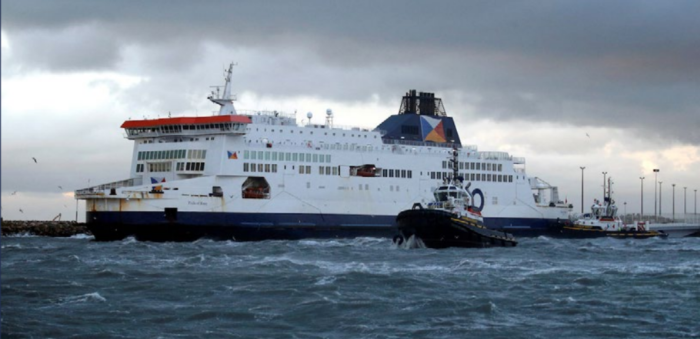The UK MAIB issued an investigation report on the UK-registered ro-ro passenger ferry, Pride of Kent, that struck a jetty and then grounded while departing Calais, France, on December 2017 amid loss of control. The ferry was re-floated later that day and moved to a berth where the passengers disembarked. The ferry’s starboard propeller and tail-shaft were damaged and required repair in dry dock. The jetty was also damaged. No injuries and pollution were reported.
The Incident
On December 10, 2017, the ro-ro Pride of Kent was approaching Calais. On the bridge was the master, an officer of the watch, an assisting officer, and a helmsman. As the vessel passed the breakwaters, the Master noticed that the wind speed had rose and ordered the bridge team to inform him if there were any exceptional gusts.
As the wind was increasing, the vessel’s bow came close to the linkspan landing pads and the master assessed that he would be unable to keep the stern alongside the berth.
After that, Pride of Kent’s master immediately advised the bridge team that he was aborting the berthing and that tug assistance was required. Although the ferry was close to berth 6, no.1 bow thruster stopped.
As the ro-ro vessel was close to the jetty, the ferry’s starboard side struck the jetty piles. The ferry moved ahead with the propellers still turning and the rudders full to port.
About 20 seconds later, the starboard propeller shaft stopped on overload and the ferry then grounded in the shallow water to the west of the jetty.
Probable cause
According to the UK MAIB, the following played an important role in the incident:
- The fast rate of turn as it passed through its intended heading.
- The loss of one of the ferry’s two bow thrusters during the turn.
- Lateral movement resulting from leeway induced by winds exceeding 50 knots and the thrust effect of using full port rudder with maximum propeller pitch ahead.
Other factors that also had a bearing on decision-making, the bridge team’s performance, and machinery reliability included:
- The master’s concern that the wind speed might increase to over 40 knots, the threshhold for having a tug available, influenced the timing of the ferry’s departure.
- The omission of a departure brief contributed to the master not being fully supported, and the inexperienced helmsman not being closely supervised.
- Fuel pump problems following a change to ultra-low sulphur fuel oil had occasionally resulted in bow thrusters tripping and reduced engine speed and shaft speeds when manoeuvring.
Conclusions
- Control of Pride of Kent’s movement was lost due to a combination of factors, including the timing and effectiveness of the actions taken to check the ferry’s fast rate of turn, winds in excess of 50kts acting on the port side, and the use of full port rudder with maximum propeller pitch ahead.
- The aborted berthing manoeuvre on arrival, the resulting delay to the ferry’s schedule, and the wind conditions, might have induced the master to subconsciously impose pressure on himself to sail as soon as possible, and probably led him to opt to sail without briefing the bridge team on the departure manoeuvre.
- After the ferry’s heading had passed through the wind, the master had not appreciated the significance of the continuing fast rate of turn combined with the limitations of the single bow thruster in winds that were now exceeding 50kts.
- The ferry’s movement towards ro-ro jetty was exacerbated by the lateral forces generated by the water flow from the propellers at maximum pitch passing by the fully angled high lift rudders.
- The helmsman’s use of full rudder angle was well-intended but reflected his relative inexperience and a lack of training on high-lift rudders.
- The omission of a departure brief prior to Pride of Kent sailing from Calais contributed to the master not being fully supported, and the actions of the inexperienced helmsman not being closely monitored.
- Despite the variability of the wind speed and the use of No.1 bow thruster having been lost temporarily during the ferry’s arrival into Calais, the possibility of something going wrong during the departure manoeuvre was not considered.
- The actions taken immediately prior to Pride of Kent colliding with ro-ro jetty indicate that the master continued to hope that he could drive the ferry clear. However, by keeping the shafts turning, the likelihood of damage to the starboard propeller and shaft was increased.
- Pride of Kent’s No.1 bow thruster tripped during the ferry’s arrival and departure from Calais on 10 December due to the reduced performance of the port main engines’ fuel pumps. Problems with the fuel pumps had been experienced since the introduction to ULSFO 6 months earlier.
- The increased likelihood of a bow thruster tripping and reduced main engine and shaft speeds when manoeuvring, warranted a more critical assessment of the status of the ferry’s propulsion.
Actions Taken
P&O Ferries moved forward to
- Develop a simulator-based programme of training for masters to include, among other things, machinery failures and emergencies.
- Highlight to its fleet the requirement for effective bridge team briefings, contingency plans, and allowances for deficiencies in vessel performance.
- Amend its fleet regulations with regard to bridge resource management and tug requirements.
- Revert to the use of MGO on board Pride of Kent pending assessment of the problems associated with ULSFO.
- Introduce a procedure to monitor the performance of its bridge teams with a focus on bridge resource management, including the effectiveness of helmsman training, taking into account the value of onboard assessments.
- Develop and implement a plan for monitoring and assessing the impact of ultra-low sulphur fuel on the reliability and performance of Pride of Kent’s propulsion should it be re introduced in the future.
Based on the actions that have already been taken, no recommendations have been made.
For more information, click on the PDF herebelow































































